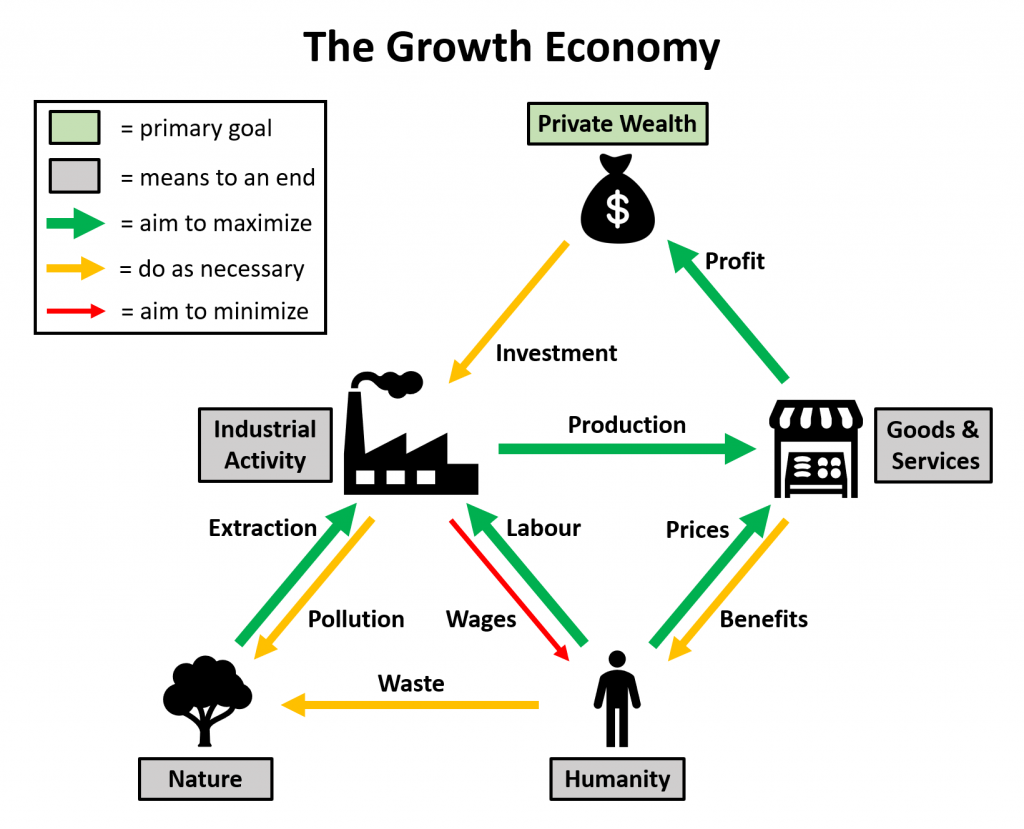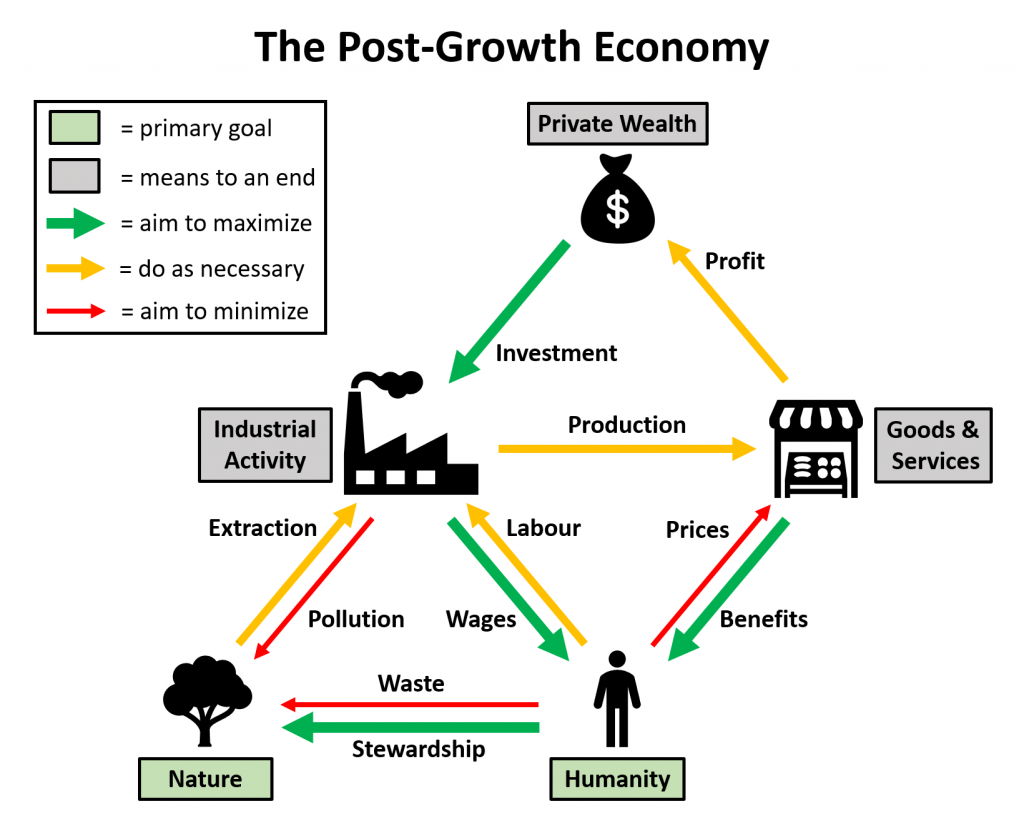
My engineering education has taught me to think in terms of systems: inputs, outputs, and everything that happens in between. So while my PhD research focuses on clean energy technology, I cannot help pondering the big picture of the world’s problems and their underlying causes. I have found clarity in the writings of ecological economists, who argue that what the world really needs is a new economic system. The purpose of this blog is to promote awareness and discussion of this idea.
The diagram below is my own (highly simplified) visualization of our 500-year-old capitalist economic system, which some call “the growth economy”.

As the diagram shows, the primary goal of this system is to increase private wealth (capital) as much as possible, forever. This requires maximizing extraction, labour, production, and prices while minimizing wages and polluting/wasting as much as necessary. Some wealth is invested back into the economy, but only if it can generate even more private wealth. As for human benefits, they are merely a necessary by-product of the system, rather than the goal. If you follow the diagram, you will probably conclude that ecological breakdown and extreme inequality are inevitable as this system grows and grows without limit.
Indeed, growing rates of extraction, pollution, and waste are now triggering global ecological crises such as climate change, deforestation, and biodiversity loss. And of the $400 trillion in wealth that the system has produced at the expense of the planet, a staggering 43% has gone to the wealthiest 1% of the population. Beyond inequality, the system is far more violent than the diagram can show. The modern world could not have been built without centuries of invasions, genocides, and slavery to enable increased exploitation of nature and human labour for private gain. People are still suffering from these injustices across the globe.
The good news is that the human benefit by-product of the growth economy has enabled more and more people to access knowledge, skills, energy, healthcare, technology, communication, and political agency. Just as children and plants only grow until they reach maturity, developed nations have reached “economic maturity”, and ecological economists argue that additional growth is unnecessary for prosperity.
They argue further that since the global economy already exceeds Earth’s planetary boundaries, developed nations must undergo economic “degrowth” to make room for developing nations to achieve good living standards. But don’t worry – developed nations are so economically wasteful that there is plenty of room for degrowth without sacrificing prosperity. We can achieve the necessary changes by transitioning to a post-growth economy.
The previous diagram is adjusted below to show what a post-growth economy might look like. Now the primary goal is to improve human wellbeing as much as possible, while also preserving nature as much as possible, forever. This results in a sustainable balance that requires limits (see Doughnut Economics), as opposed to the fantasy of limitlessness that is built into the growth economy.

The diagram shows that in a post-growth economy, we only extract and produce as much as necessary for human prosperity, while minimizing pollution and waste. People only work as much as necessary, but we maximize their compensation for work done. Goods and services are designed for maximum human benefit, but at a minimum personal price. To ensure that the system sustains for future generations, we actively maintain the health of the natural world through environmental stewardship. To drive this new system forward, we harness some of the world’s existing private wealth and limit additional private profit.
What concrete steps could we take towards a post-growth economy? Experts have proposed many different ideas. Here are just a few:
– Replacing GDP with a new prosperity indicator that better represents well-being.
– Abolishing debt-based currency, since it demands endless economic growth.
– Setting caps on resource and energy use to drive degrowth in destructive/wasteful industries (such as fossil fuels, beef, plastics, electronics, and transportation).
– Shortening the work week so people can work less and live more as industrial degrowth reduces labour requirements.
– Setting an upper limit on salaries while raising the minimum wage.
– Taxing extreme wealth and investing it in the public interest (see next point).
– Investing in universal basic services (such as income, housing, food, water, healthcare, education, transportation, clean energy, and internet) to guarantee everyone a good standard of living.
These are major societal changes and they will not be easy to implement, but there is no easy path ahead. In terms of climate change alone, it will be extremely difficult to achieve our CO2 reduction targets if we continue to grow the global economy.
We are deeply entrenched in a flawed economic system, and we must be willing to change it if we are serious about the future. COVID-19 has been devastating, but it has provided us with an opportunity to begin the transition to a new economic system that is built around sustainability and justice. It’s time.
This blog has only scratched the surface of a fascinating subject. If you are interested in learning more, I highly recommend reading authors such as Jason Hickel, Kate Raworth, Julia Steinberger, Giorgos Kallis, and Tim Jackson. I’m sure there are many others I am yet to discover.
Image by Alexas_Fotos from Pixabay










